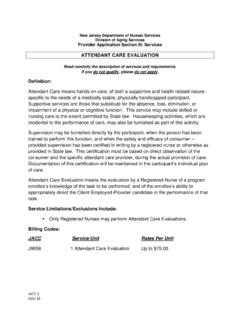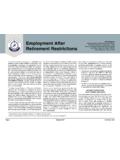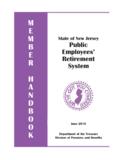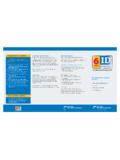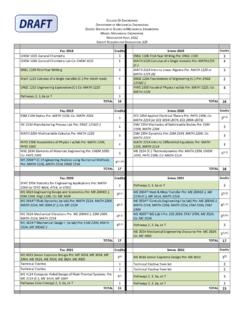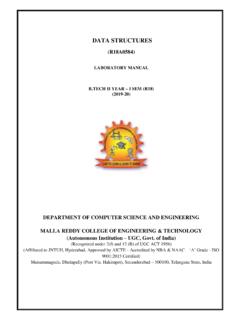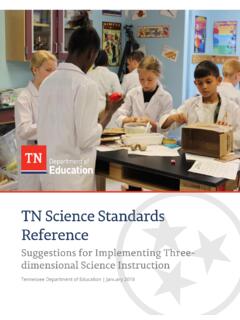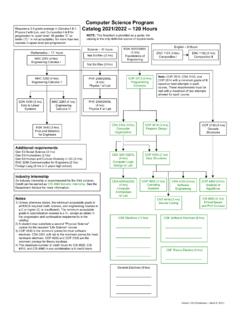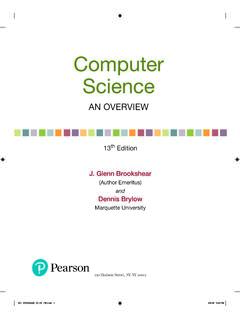Transcription of Computer Science and Design Thinking NJSLS 2020 (June)
1 2020 New Jersey Student Learning Standards Computer Science and Design Thinking Introduction Computer Science and Design Thinking New approaches necessary for solving the critical challenges that we face as a society will require harnessing the power of technology and computing. Rapidly changing technologies and the proliferation of digital information have permeated and radically transformed learning, working, and everyday life. To be well-educated, global-minded individuals in a computing-intensive world, students must have a clear understanding of the concepts and practices of Computer Science . As education systems adapt to a vision of students who are not just Computer users but also computationally literate creators who are proficient in the concepts and practices of Computer Science and Design Thinking , engaging students in computational Thinking and human-centered approaches to Design through the study of Computer Science and technology serves to prepare students to ethically produce and critically consume technology.
2 Mission Computer Science and Design Thinking education prepares students to succeed in today's knowledge-based economy by providing equitable and expanded access to high-quality, standards-based Computer Science and technological Design education. Vision All students have equitable access to a rigorous Computer Science and Design Thinking education. Students will benefit from opportunities to engage in high-quality technology programs that foster their ability to: develop and apply computational and Design Thinking to address real-world problems and Design creative solutions; engage as collaborators, innovators, and entrepreneurs on a clear pathway to success through postsecondary education and careers; navigate the dynamic digital landscape to become healthy, productive, 21st century global-minded individuals.
3 And participate in an inclusive and diverse computing culture that appreciates and incorporates perspectives from people of different genders, ethnicities, and abilities. New Jersey Department of EducationJune 20201 Intent and Spirit of the Computer Science and Design Thinking Standards All students receive Computer Science and Design Thinking instruction from Kindergarten through grade 12. The study of these disciplines focuses on deep understanding of concepts that enable students to think critically and systematically about leveraging technology to solve local and global issues. Authentic learning experiences that enable students to apply content knowledge, integrate concepts across disciplines, develop computational Thinking skills, acquire and incorporate varied perspectives, and communicate with diverse audiences about the use and effects of computing prepares New Jersey students for college and careers.
4 Revised Standards Framework for NJ Designed Standards New to this version of the NJSLS -CS&DT are the following: Standard Computer ScienceoComputer Science , previously a strand entitled Computational Thinking : Programming in standard of the 2014 NJSLS -Technology, outlines a comprehensive set of concepts and skills, such as data and analysis, algorithms and programming, andcomputing systems. Standard Design ThinkingoThis standard, previously standard Technology Education of the 2014 NJSLS Technology, outlines the technological designconcepts and skills essential for technological and engineering literacy. The new framework Design , detailed previously, includesEngineering Design , Ethics and Culture, and the Effects of Technology on the Natural world among the disciplinary concepts.
5 *Please note that the concepts and skills previously included in Educational Technology of the 2014 NJSLS Technology have beenexpanded and integrated across multiple disciplinary concepts in the 2020 NJSLS Career Readiness, Life Literacies, and Key Skillsstandard Given the ubiquity of technology, our students will continue to be required to demonstrate increasing levels of proficiency toaccess, manage, evaluate, and synthesize information in their personal, academic, and professional lives. Therefore, the standards that werehoused in one discipline have been enhanced and restructured to reflect the continued need for student learning in technology literacy, digitalcitizenship, and information and media Design of this version of the NJSLS Computer Science and Design Thinking ( NJSLS -CS&DT) is intended to: promote the development of curricula and learning experiences that reflect the vision and mission of Computer Science and Design Thinking asstated in the beginning of this document; foster greater coherence and appropriate progressions across grade bands.
6 Prioritize the important ideas and core processes that are central to computing and have lasting value beyond the classroom; and reflect the habits of mind central to technology that lead to post-secondary Jersey Department of EducationJune 20202 In this diagram: The Vision and Mission serve as the foundation for each content areas standards. They describe the important role of the discipline in the world and reflect the various statutes, regulations, and policy. The Performance Expectations are the studs and serve as the framework for what students should know and be able to do. They incorporate the knowledge and skills that are most important for students to know in order to be prepared for post-secondary success.
7 The Disciplinary Concepts and Core Ideas are the joists and play an integral role in the framing by making connections among the performance expectations. Core ideas help to prioritize the important ideas and core processes that are central to a discipline and have lasting value beyond the classroom. They provide clear guidance as to what should be the focus of learning by the end of each grade band ( , end of grades 2, 5, 8, and 12). The Practices are the roof and represent two key ideas. Positioned as the top of the house, they represent the apex of learning. The goal is for students to internalize the practices (habits of mind) and be able to apply them to new situations outside the school environment.
8 The practices span across all aspects of the standards and are an integral part of K-12 students learning of the disciplines. Practices Disciplinary Concepts and Core Ideas Performance Expectations Vision and Mission New Jersey Department of EducationJune 20203 Disciplinary Concepts and Core Ideas Computing Systems People interact with a wide variety of computing devices that collect, store, analyze, and act upon information in ways that can affect human capabilities both positively and negatively. The physical components (hardware) and instructions (software) that make up a computing system communicate and process information in digital form.
9 By the end of grade 2 By the end of grade 5 By the end of grade 8 By the end of grade 12 Individuals use computing devices to perform a variety of tasks accurately and quickly. Computing devices interpret and follow the instructions they are given literally. A computing system is composed of software and hardware. Describing a problem is the first step toward finding a solution when computing systems do not work as expected. Computing devices may be connected to other devices to form a system as a way to extend their capabilities. Software and hardware work together as a system to accomplish tasks ( , sending, receiving, processing, and storing units of information).
10 Shared features allow for common troubleshooting strategies that can be effective for many systems. The study of human- Computer interaction can improve the Design of devices and extend the abilities of humans. Software and hardware determine a computing system s capability to store and process information. The Design or selection of a computing system involves multiple considerations and potential trade-offs. Troubleshooting a problem is more effective when knowledge of the specific device along with a systematic process is used to identify the source of a problem. The usability, dependability, security, and accessibility of devices within integrated systems are important considerations in their Design as they evolve.
